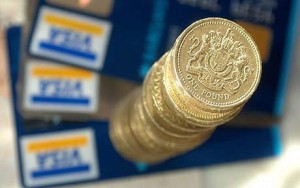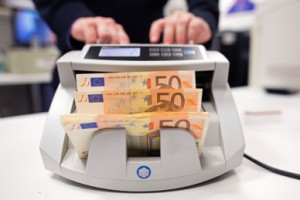Insolvency versus Liquidity:
The problem is that sovereign borrowers are insolvent. They cannot pay back their debts, as Greece is going to prove by defaulting on their debt and to keep the EU intact, being bailed out by the ECB. However Central Bankers treat the matter as a liquidity problem; they must know they cannot make them solvent? So, they lend them more and more money, on easier terms, knowing that they never will be paid back.
Central bankers never came up with proposals to make sovereigns at least less insolvent to get them back on their feet. Nor much thought has been given to the consequences, about all this added new debt that increases the borrowers’ burden, nor to what will happen when investors realize that the system is ridiculous and doomed.
“The sovereigns owe a lot of money that they can’t repay. As they try to roll over their existing debts and have to borrow more, the lenders – if any can be found – will want higher and eventually unaffordable interest rates. When the lenders dry up, the only solution will be for the central bankers to monetize, but the world will be watching closely, so this will likely trigger a death spiral in the fiat currencies.” Argues Doug Casey.
 There are intractable problems on a fundamental, systemic basis that cannot be resolved in an orderly fashion. The day is coming when more lending doesn’t make sense anymore, after which point everything starts to fall apart.
There are intractable problems on a fundamental, systemic basis that cannot be resolved in an orderly fashion. The day is coming when more lending doesn’t make sense anymore, after which point everything starts to fall apart.
Global growth is slowing. US corporate earnings are falling. Europe is in danger of coming unstuck in June, when the Greeks have to face up to making a big payment on their debt. And China looks more and more like a massive case of mal-investment on the verge of going bad. – When the crash comes, everyone rushes for the door. The sellers are all there, but no buyers, they have disappeared, like the credit and the cash.
We don’t know how it will end, but something has to give. It’s a question of what it will be. Because when you start playing with the forces of nature, you can suppress them for a while, but they will eventually overwhelm you. We’ve seen this constantly throughout history. Grant Williams
ZIRP – zero-interest-rate policy- and QE – quantitative easing accomplish the same thing as money printing but by different means. They make credit – and speculation – cheaper by lowering borrowing costs.
As long as credit continues to expand, a credit card will be as good as cash. Adding credit to the system, rather than cash, is how the banks got rich. They sold credit! That is why the rich got richer; they were creditworthy! They could take the cheap credit and bid for stocks and bonds – driving up asset prices.
But there’s one big difference between cash and credit: In a crisis, credit collapses. Cash – even cash backed by nothing – nevertheless has a physical, tangible presence. If the stock market gets cut in half, those slips of paper are still there. These still can be used to buy a drink or food.
But in a real credit crisis like in 2008, every bank on Wall Street would have gone broke had the feds not intervened so vigorously with pumping 26 trillion in the system, although government lied about telling it just was over 1 trillion. – Credit works on trust. Someone with a huge line of credit at Lehman Brothers in 2008 went out of business; his credit had vanished.
But in the next crisis when all asset classes are affected at once, the collateral of the banking industry would fall. The banks would look at each other and wonder whose credit was still good. Merchants would look at your credit card and wonder if its  issuer was still in business.
issuer was still in business.
“Trust would disappear. And along with it, credit. The economy would go into free fall. – Then the big surprise: Instead of inflation or hyperinflation that many expect, suddenly the dollar – the almighty dollar – the old-fashioned, paper, greenback buck – would become more valuable.”
Catastrophic Twist:
The financial system could take a surprising and catastrophic twist that almost nobody imagines, let alone anticipate. Cash could evaporate suddenly and disastrously – just before the world drowns in it. “Look at M2 money supply — which measures coins and notes in circulation as well as bank deposits and money market accounts – America’s money stock amounted to $11.7 trillion as of last year. But there was just $1.3 trillion of physical currency in circulation — about only half of which is in the US. – Nobody knows for sure.”
What is used, as money today is mostly credit. It exists as zeros and ones in electronic bank accounts. People never see it, touch it, feel it, or count it out. – The banks profit – handsomely – by creating this credit. And as long as banks have sufficient capital, they are happy to create as much credit, as people are willing to pay for. – After all, it costs the banks almost nothing to create new credit. That’s why there is so much of it.
Such a monetary system never before has existed. And the current one has existed only during a time when credit was undergoing an epic expansion. – But it never has been thoroughly tested, to understand how it will hold up in a deep or prolonged credit contraction. Can it survive an extended bear market in bonds or stocks? What would happen if consumer prices were out of control?
Central bankers dropped the price of credit to zero and even below zero, by slashing short-term interest rates and buying trillions of dollars of government bonds. According to a study by McKinsey, “the world’s total debt – at least as officially recorded – now stands at $200 trillion – up $57 trillion since 2007. That’s 286% of global GDP… and far in excess of what the real economy can support.”
 At some point, a debt correction is inevitable. Debt expansions are ‘always‘ followed by debt contractions. There is no other way, as debt cannot increase forever. When that happens, ZIRP and QE will not be enough to reverse the process, because they already are running at full speed, and there is no alternative available.
At some point, a debt correction is inevitable. Debt expansions are ‘always‘ followed by debt contractions. There is no other way, as debt cannot increase forever. When that happens, ZIRP and QE will not be enough to reverse the process, because they already are running at full speed, and there is no alternative available.
Then the value of debt will drop sharply and fast. Creditors look to their borrowers – traders look at their counterparties – bankers look at each other – and suddenly, no one wants to part with a penny, for fear they may never see it again. – Credit stops. – It’s not just that no one wants to lend, no one wants to borrow either.
Just like after the 2008 crisis, expect a quick response from the central bankers. – They will announce unlimited new borrowing facilities. But it won’t matter. House prices will be crashing. No one will lend against the value of a house. Stock prices will be crashing. – No one will be able to borrow against his stocks. Art, collectibles and resources – all will be in free fall. The next crisis is likely to be across ALL asset classes. And with $57 trillion more in global debt than in 2008, it is likely to be much harder to stop.
Did you follow it so far? Because here is where it gets interesting. In a gold-backed monetary system prices fall. But the money is still there. Money becomes more valuable. It doesn’t disappear. It is more valuable because you can use it to buy more stuff.
Obviously, people hold on to it. Of course, the velocity of money – the frequency at which each unit of currency is used to buy something – falls. And this makes it appear that the supply of money is falling too. But imagine what happens to credit money. The money doesn’t just stop circulating. It vanishes.
A bank that had an “asset” – in the form of a loan to a customer – of $100,000 in June, may have zero by July. A corporation that splurged on share buybacks one week, could find those shares cut in half two weeks later. A person with a $100,000 stock market portfolio one day could find his portfolio has no value at all.
All of this is standard food for a credit crisis. The new wrinkle – a devastating one – is that people now do what they always  do, but they are forced to do it in a radically different way. – They stop spending. They hoard cash. But what cash do you hoard when most transactions are done on credit? Do you hoard a line of credit? Do you put your credit card in your vault? – No. – People will hoard the kind of cash they understand – something they can put their hands on – something that is gaining value – rapidly. They’ll want the paper bills.
do, but they are forced to do it in a radically different way. – They stop spending. They hoard cash. But what cash do you hoard when most transactions are done on credit? Do you hoard a line of credit? Do you put your credit card in your vault? – No. – People will hoard the kind of cash they understand – something they can put their hands on – something that is gaining value – rapidly. They’ll want the paper bills.
But, following a well-known pattern, these paper bills will quickly disappear. People drain cash machines. They drain credit facilities. They ask for “cash back” when they use their credit cards. They want real money – old-fashioned money that they can put in their pockets and in their home safes.
Readers are reminded that “all this happens in a short timeframe – days… maybe weeks… a couple of months at most. That’s all. It’s the period after the credit crisis has sucked the cash out of the system… and before the government’s inflation tsunami has hit.”
As Central Bankers put it, “a determined central banker can always create positive consumer price inflation.” But that takes time!
Panic:
And during that interval, panic will set in. A paper currency panic – with people desperate to put their hands on paper bills – to pay for food, for fuel, and for everything else they need.
Credit facilities will be drained of real cash. Banks will put up signs, first: “Cash withdrawals limited to $500.” And then: “No Cash Withdrawals.” You need to buy gasoline. “Cash Only,” the sign will say, as the machinery of the credit economy will be  breaking down. The gas station… its suppliers… and its financiers do not want to get stuck with a “credit” from your bankrupt lender!
breaking down. The gas station… its suppliers… and its financiers do not want to get stuck with a “credit” from your bankrupt lender!
Whose lines of credit are still valuable? No one will know the answers. Quickly, they will stop guessing – and turn to cash. – Advice: Keep some on hand. You may need it.
Clearly we live in a world that seems to have abandoned the concept of savings and investments as the source of real wealth and economic growth. Policy makers focus on spurring consumption, while ignoring the even greater importance of production. The so-called capitalists have forgotten that capital cannot be created by government’s fiat money.
Control of the world’s economy has been placed in the hands of a private banking cartel, which holds great danger for all of us. True prosperity requires sound money, increased productivity, and increased savings and investment. The world is awash in US dollars, Euros, Yen, Yuan, and pounds. A currency crisis involving the world’s reserve currency would be an unprecedented catastrophe. No amount of monetary expansion can resolve those current financial problems, but it can make those problems much worse.
When that event becomes inevitable, the only thing left to do is prepare oneself for it. Be aware a price collapse is coming, but not for gold and silver. Instead, the market for US dollars and Euros debt denominated in those currencies is headed to fall off a cliff, which will send the price of precious metals soaring.
Now is the time for uncommon confidence. Everyone knows Treasuries are safe, just as they knew house prices would always rise. Then as now, gold’s and silver value and utility are doubted. But hopefully you’ll be wiser by now to stay ahead with your preparations before the trouble breaks-out.
Return on Investment:
To make a return on investment, investors have to take extreme risks, as result of today’s overly loose monetary policy that will have a disastrous effect by promoting reckless speculation and enhancing the ability of low-quality borrowers to issue debt to yield-starved investors. This encourages mal-investment and financial distortions that then collapse, as seen following the tech and housing bubbles. Those seeds have now been sown for the third time in 15 years. All bubbles burst. They burst whether the Fed is raising rates or lowering them. And all bubbles burst in a way that destroys credit but raises up the value of cash. This is the curious phenomenon that almost nobody sees coming!
Consider this: Over € 1.2 trillion, and rapidly rising, worth of European government bonds now sport negative yields. That’s about 25 percent of the total of sovereign securities within the EU. Want to actually earn a return in German debt? Now you have to buy securities with a maturity of more than seven years! The ECB currently says it won’t buy anything yielding less than minus 0.20 percent. But that means it may not be able to snap up the 1.1 trillion euros worth of debt.
Macht ohne Kontrolle – Die Troika – The powerful Troika robs the people.
Definitely a must for anyone who wants to know how the Rothschild Zionists with their fascist practices across Europe rob the countries and its citizens. You sit with this video front row, if at least you’re awake enough, and you will watch step by step how this GRAND THEFT is being executed. Breath taking especially when you consider that is going to happen to all of us. Very Sad – depressing – and True! – A CALL to WAKE UP and to oppose against it.
Market Crash in September 2015
David Morgan of Silver-Investor.com says the world is loaded with debt that is going to explode. It’s just a matter of time. When might the economy and the “debt bomb” explode? Morgan predicts this fall. Why? Morgan says, “Momentum is one indicator and the money supply. Also, when I made my forecast, there is a big seasonality, and part of it is strict analytical detail and part of it is being in this market for 40 years. I got a pretty good idea of what is going on out there and the feedback I get. – I’m in Europe, I’m in Asia, I’m in South America, I’m in Mexico, I’m in Canada; and so, I get a global feel, if you will, for what people are really thinking and really dealing with. It’s like a barometer reading, and I feel there are more and more tensions all the time and less and less solutions. It’s a fundamental take on how fed up people are on a global basis. Based on that, it seems to me as I said in the January issue of the Morgan Report, September is going to be the point where people have had it.”
Leave a Reply